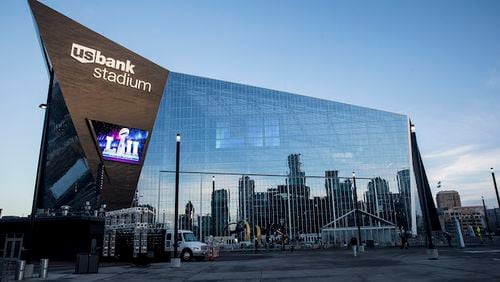They are the NFL’s two newest stadiums – U.S. Bank Stadium in downtown Minneapolis, where Sunday’s Super Bowl will be played, and Mercedes-Benz Stadium in downtown Atlanta, where next year’s Super Bowl will be played. Let’s compare them.
WHEN THEY OPENED
U.S. Bank Stadium opened in 2016, Mercedes-Benz Stadium one year later.
THE DESIGNS
From the exterior, some have likened the look of U.S. Bank Stadium to a Viking ship and the look of Mercedes-Benz Stadium to a space ship. Both are innovative designs that feature lots of angles, lots of premium amenities and lots of glass (and a glass-like plastic known as ETFE). The Minnesota stadium has five 95-foot-high pivoting glass doors, sure to be closed Sunday with temperatures forecast in the single digits, and large video screens behind both end zones. The Atlanta stadium has a wall of windows behind one end zone and a massive oval-shaped video “halo” board.
THE ROOFS
U.S. Bank Stadium is an indoor facility with a fixed, steeply slanted, transparent roof. Officials opted against a retractable roof because of the added cost and how rarely it would be open during football season in Minnesota weather. Mercedes-Benz Stadium has an eight-panel retractable roof that is still a work in progress and was open for events only twice in the stadium's first five months.
THE COSTS
U.S. Bank Stadium cost $1.1 billion, up from a $975 million budget at the start of construction. Mercedes-Benz Stadium cost at least $1.5 billion, up from a $1.2 billion budget at the start of construction. Taxpayers contributed $498 million, plus interest, toward construction of the Minnesota stadium and $200 million, plus interest, toward construction of the Atlanta stadium. But because hundreds of millions of additional dollars from Atlanta’s hotel-motel tax will go toward Mercedes-Benz Stadium over the next 30 years (the exact amount depending on tax collections), it’s not clear which project will wind up receiving the most public funds.
PERSONAL SEAT LICENSES
The Vikings and Falcons were the 18th and 19th NFL teams to use personal seat licenses -- one-time fees for the right to purchase season tickets -- as part of their stadium financing plans. The Vikings’ PSLs were cheaper, priced from $500 to $9,500, and generated about $125 million in revenue. The Falcons’ PSLs were priced from $500 to $45,000 and generated about $267 million (as of the stadium’s opening).
CONCESSION PRICES
Food and beverages are cheaper in Mercedes-Benz Stadium, where some items, including hot dogs and soft drinks, go for $2. (The Falcons say the prices won’t change for next year’s Super Bowl.) Concession prices at U.S. Bank Stadium are more typical of pro sports venues.
FINISHING TOUCHES
A plaza outside U.S. Bank Stadium features a 160-foot-long “Legacy Ship,” with a built-in video board. A plaza outside Mercedes-Benz Stadium features a 41-foot-tall falcon statue.
MEGA-EVENTS
The stadiums have more than Super Bowls in common. Both are scheduled to host college basketball’s Final Four, U.S. Bank Stadium in 2019 and Mercedes-Benz Stadium in 2020. Mercedes-Benz Stadium hosted college football’s national championship game earlier this year, while U.S. Bank Stadium lost a bid to host that event in 2020.
NOT THE NEWEST FOR LONG
These won’t be the NFL’s two newest stadiums for long. A Los Angeles stadium for the Rams and Chargers is under construction and scheduled to open in 2020. Also in 2020, a new Las Vegas stadium is slated to open for the relocating Raiders. The L.A. stadium will host the Super Bowl in 2022, and the Vegas stadium probably will get one not long after that, in keeping with the NFL’s practice of awarding its biggest event to cities that fund stadiums.
About the Author







